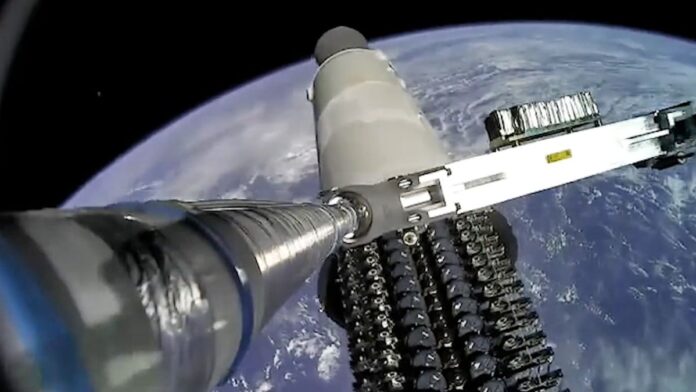A new generation of Starlink internet satellites has been deployed in space.
Spectacular video from SpaceX shows 21 of SpaceX’s new Starlink “V2 mini” satellites leaving their Falcon 9 rocket after launch on Monday (Feb. 27), as shared by founder Elon Musk on Twitter (opens in new tab).
The satellites launched on their debut mission at 6:13 p.m. EST (2313 GMT) Monday from Florida’s Cape Canaveral Space Force Station. The Falcon 9’s first stage came back to Earth atop the SpaceX droneship A Shortfall of Gravitas 8.5 minutes after liftoff, in the Atlantic Ocean off the Florida coast.
These mini-test satellites will be used ahead of deploying full-size Starlink V2s aboard Starship, which can heft bigger ones with a mass of 1.25 tons (1,130 kilograms) to orbit once it is ready to go. A test launch with Starship may happen later this month.
Related: 10 weird things about SpaceX’s Starlink internet satellites
The satellites themselves were deployed about 64.5 minutes after liftoff, SpaceX has said. In the company’s new video, a camera mounted on a boom arm folds out away from the satellites as they separate from their Falcon 9 rocket upper stage.
“V2 minis include key technologies — such as more powerful phased array antennas and the use of E-band for backhaul — which will allow Starlink to provide ~4x more capacity per satellite than earlier iterations,” SpaceX said via Twitter on Sunday (opens in new tab) (Feb. 26).
The V2 minis also have argon Hall thrusters, which are being used for the first time in space. The new thrusters “have 2.4x the thrust and 1.5x the specific impulse of our first gen thrusters,” SpaceX said in another Sunday tweet (opens in new tab).

(opens in new tab)
SpaceX has more than 4,000 Starlink satellites (opens in new tab) launched for internet service around worldwide, and has plans to send up many more. SpaceX has regulatory permission to send up 12,000 Starlink craft and asked for approval to deploy nearly 30,000 satellites on top of that.
The company originally planned to have three launches on Monday, but the other two faced delays. Crew-6’s planned liftoff that day was scrubbed due to a ground-system issue late in the countdown. The next possible Crew-6 launch opportunity is Thursday (March 2) at 12:34 a.m. EST (0534 GMT).
The company also planned a Starlink launch from Vandenberg Space Force Base in California on Monday afternoon, now scheduled for today at 2:20 p.m. EST (1920 GMT or 11:20 a.m. local time).
Elizabeth Howell is the co-author of “Why Am I Taller (opens in new tab)?” (ECW Press, 2022; with Canadian astronaut Dave Williams), a book about space medicine. Follow her on Twitter @howellspace (opens in new tab). Follow us on Twitter @Spacedotcom (opens in new tab) or Facebook (opens in new tab).

